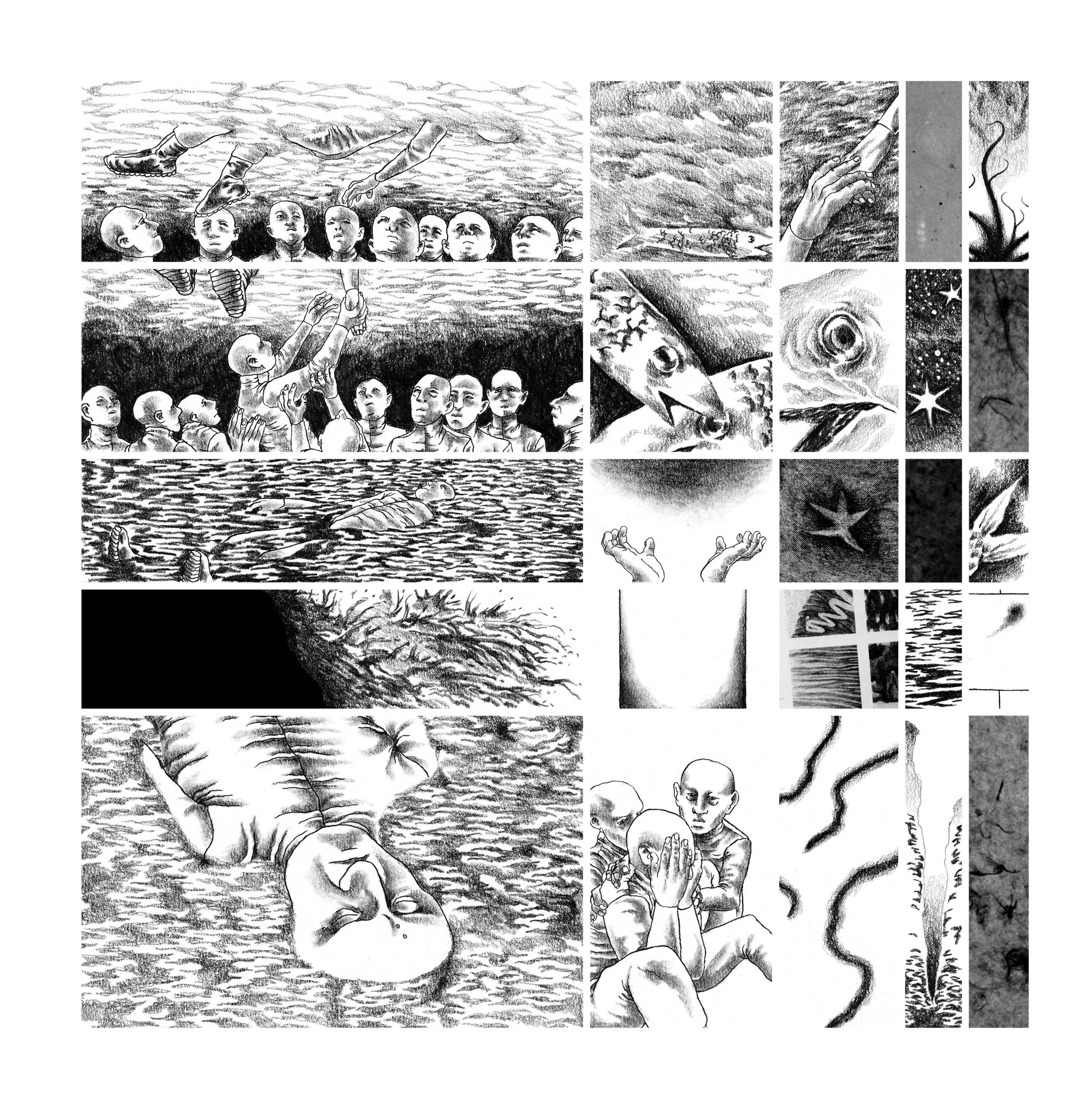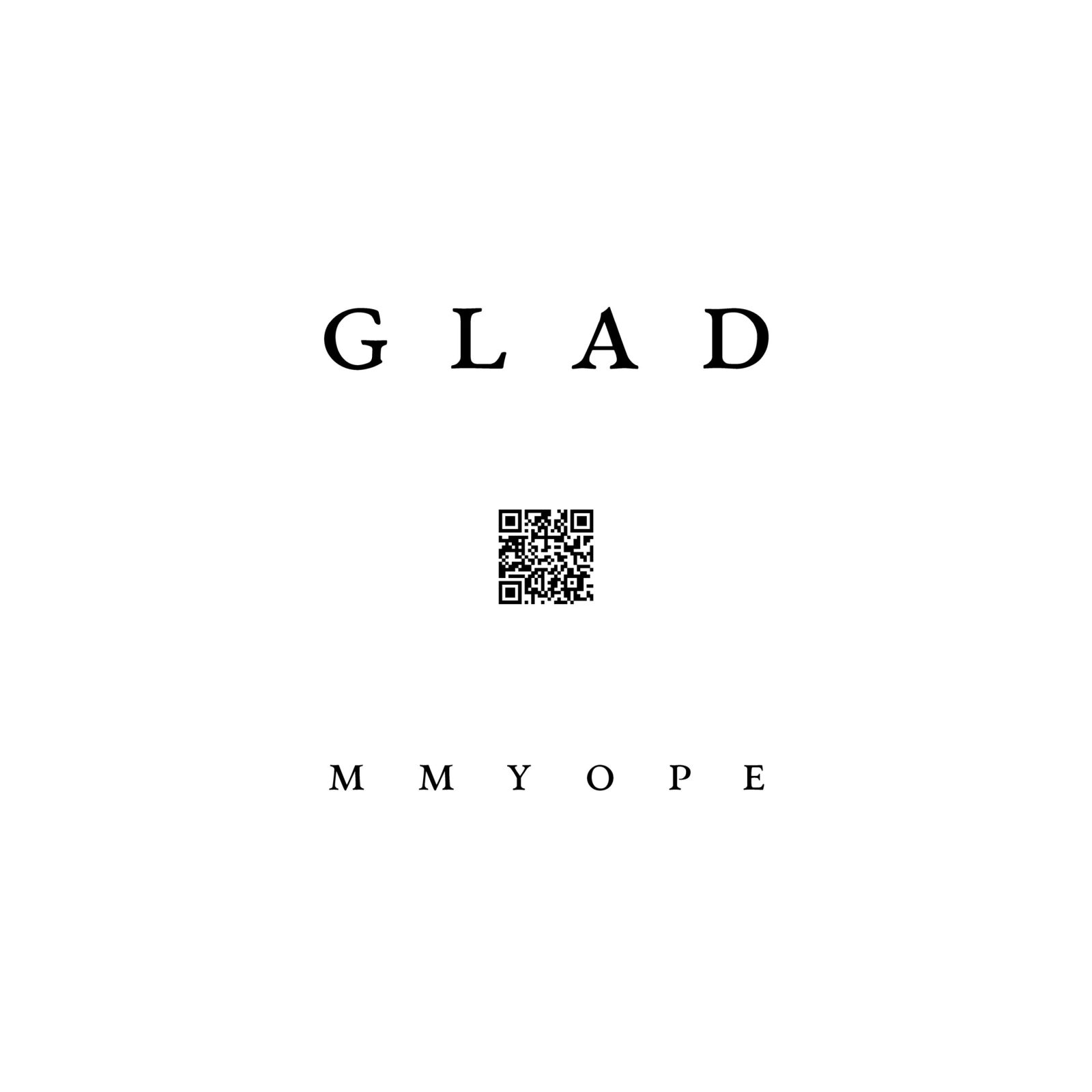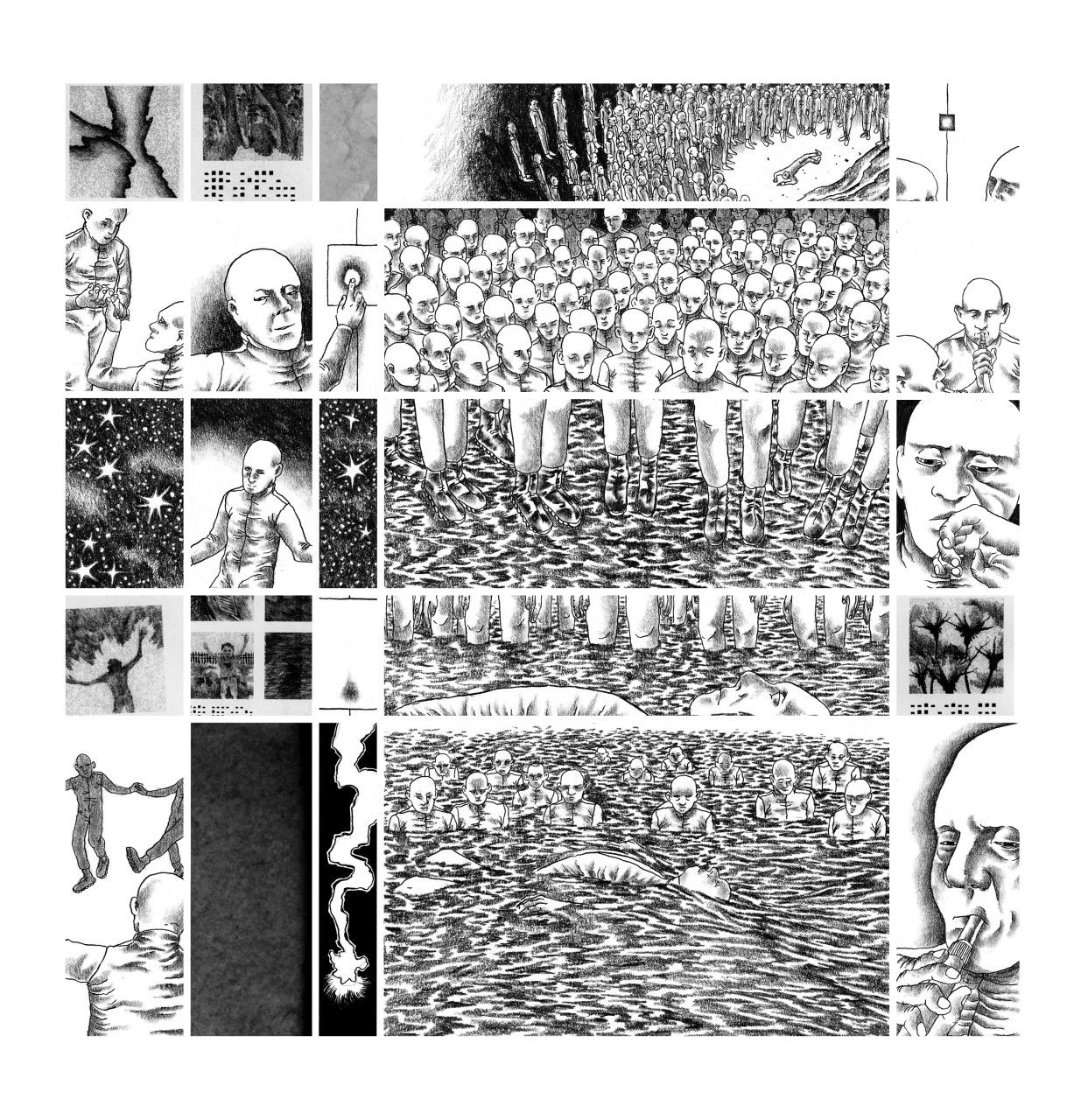In 2021, a New York-based entity calling itself MMYOPE published three handsomely-formatted books in relatively quick succession: NYC TAP/I’m Very Fond of You, a split “flip book” release delineating the discrete wordless journeys of a plant leaf and a humanoid giant (and those whose paths they cross) that meet in the middle to form both an ending and joining together of the narratives; Glad, a truly enormous tome that utilizes both longform verse and a very-nearly-traditional science fiction “comic” in service of thematically-apropos oblique statement on communication, longing, and that gap between the two that can never be fully resolved; and Recanting Em, a series of full-page illustrations accompanied by interpretive text at the bottom of each (which often extends beyond the borders of the page) to tell two halves of one tale, revolving once again around the trials and travails of a haggard, disheveled, borderline-emaciated human as he makes an exodus away from something known toward something that may or may not be.
Challenging works one and all, to be sure - and, in terms both thematic and stylistic, very much “of a piece” with one another while also standing on their own quite distinctly. Speaking personally, I find Recanting Em to be the most mysterious of the lot, even though it’s accompanied by the most de facto “description” - perhaps because I find the idea of one page being “right-side up” and the other “upside-down” whichever way one reads it to be inherently disconcerting. But then, I do have to concede that very sensation is part of the point, so I suppose I needn’t worry that I’m not “getting” whatever it is MMYOPE is attempting to do.

Still, there’s more to MMYOPE than mere formal experimentation - a lot more. And despite recurring themes throughout their works such as loneliness, separation, metamorphosis, reification and endless searching (among others), there’s very much a feeling that no hard and fast statements are being offered on these subjects. That the works themselves are more about asking questions—perhaps even opening a dialogue with readers, or serving as a springboard for them to explore their own thoughts on the matters at hand—than they are about providing answers. In fact, I might even go so far as to say that ultimately unanswerable questions are the sort MMYOPE is most interested in exploring.
Going one better, though, that ethos carries over from the page into the nature of the project/collective that is MMYOPE itself. Billing itself in the copyright indicia of its books as an “NYC/amorphous/kindness based group,” the central figure involved with all its projects is artist Abel Eba, whose delicate and distinctive illustrations and etchings match a keen eye for detail with an empath’s ability to accentuate mood and feeling with a neo-classicalist’s flair for romanticism. His pages can sing, scream or be silent with near-equal aplomb, and his confidence in all facets of his (forgive the use of the term, but) skill set is easy enough to see without being showy. The ideas expressed in these books may not all be his (although most would appear to be), but their ultimate expression and presentation bear his imprimatur at all times.
Still, given the fact that there is input from others to one degree or another, it would be misleading to call these books “auteur” works. They may be driven by an “auteurist” vision in service of “auteurist” ends, but the very adoption of the name MMYOPE—as well the description attached to it—calls attention to the collaborative nature of the authorship of all things appearing under said nom(s) de plume. As Eba told me, “MMYOPE is a container. It’s not really me and it’s not necessarily all my things in there, but it’s only there if I am.”
Going further to expound upon the name itself, Eba states that “MMYOPE is the French word for myopic, with an odd M in there. Myopia is when someone is afforded only a narrow band of clear sight, (and) what goes beyond it is this persistent uncertainty, though every myopic person learns to trust the permanence of their surroundings given their implied familiarity. Each MMYOPE book operates at this sort of frequency.” While I might quibble just a bit with the idea that “every” myopic person learns to trust their surroundings (indeed, the idea that many focus in so narrowly on the parts that they do trust and/or can exert control over would seem to indicate that that they have an inherent distrust for much, if not most, of what surrounds them), the general gist of what Eba has to say about the correlation between the MMYOPE name and the contents of the MMYOPE books is right on the money.
That being said, there is an ambiguous, undefined quality both to how Eba describes MMYOPE and, crucially, how he sees it. That the entity or collective is a work in progress isn’t in doubt or up for debate. The personnel involved with these books are flexible and, in accordance with the remit of the “group” itself, look to remain so for the foreseeable future. Artist Faye Blue did some of the illustrations in NYC TAP/I’m Very Fond of You, and poet Zoe Kress contributes verse to Glad, a book that also credits artist Ariana Freitag with something called “ML interventions” (your guess is as good as mine). When asked about who made up the ranks of MYYOPE for Recanting Em, Eba states almost resignedly that it was “a solo effort [and] I think that’s a real shame.”
Again, I might respectfully beg to differ with him on that score, but I give Eba credit for sticking steadfastly to his belief that bringing in other voices and other talents inherently strengthens a work - a view that, if we’re being honest, typically isn’t shared by most in small press/self-published comics (myself included), who tend toward thinking that the work an artist/cartoonist who does everything themselves is by its very nature preferable to a collaborative effort. MYYOPE, by contrast, is designed at the conceptual stage as something quite different - something created by many, even if it’s only created by one. As Eba puts it: “It is a promise and its delivery. Production leads to context - the more that is made, the more that can be made,” and “even if I will, at times, be the sole contributor, each drawing and every page is undoubtedly motivated by the love I receive.”
Which, of course, leads one to inevitably question whether or not there is such a thing as a truly “solo” effort in the first place, given that every artist is informed by the people, ideas, and environment around them. Sure, the artist is doing the actual work - but that work is more or less always a product of the larger overall zeitgeist of its time, place, and circumstance. No art exists in a vacuum because no artist exists in a vacuum, and by its very nature MYYOPE shines a light on that fact. Whether it's by accident or design, I couldn’t say for certain, but in purely practical terms it’s an almost immaterial distinction.

On other matters of consequence to both project and product, though, MMYOPE’s intentions are a unique blend of the nebulous and concrete, at times resulting in a rather enticing form of self-contradiction. Eba insists, for instance, that each MMYOPE book is an exercise in artistic “frugality,” made with “no more than is necessary,” and that his “cost per book stays relatively low” due to his use of “bottom-shelf paper, 4B pencil, and whatever pen, processed with the help of consumer-rate machines that can be reused and rethought as needed,” yet each of the volumes is a lavish physical specimen - particularly Glad, which is a coffee table-sized book. I agree fully with Eba’s statement that the books employ a “simple design language” that “upholds the integrity of the work” (I’d even go further and state that it enhances said integrity by dint of the fact that unity of form and function are central concerns of all MMYOPE projects to date), but I admit to being almost dumbfounded when he told me that the finished product is “very economical, not only financially but mentally.” From the perspective of an outsider, these books look to be exhaustively thought-through down to the very smallest of details and extremely expensive to produce, but Eba insists that because he prints in small batches, it literally “rids the work of pressure to perform” and “protect(s) the books... so they are able to flourish independent of expectations.” He goes on to say that absent this set of circumstances, “the exercise would become a venture,” and it’s plain as can be he has little to no interest in such commercial concerns.
Indeed, when asked what his chief concern with MMYOPE publications is, Eba states that it’s “how a book will read,” and extrapolates on this by adding that each “story will make demands, and I offer suggestions.” That commitment to fully involving the reader as de facto co-creator of the experience on offer (at least on an individual level) has resulted in changes being made as the works progress, but often Eba seems to find that the work as he originally envisioned it is what he returns to. The lengthy section of verse that forms the first part of Glad, for instance, was something he’d considered breaking up into sections and scattering throughout the book at various intervals, but he came back to the idea of presenting all of it at the outset because, by his telling, doing so more or less allows the reader to opt out of it and move forward into the comic “proper” at any time. In his own words: “The poem produces, and is made up of, echoes,” and his intention with it was to “not limit the reader’s approach, instead letting the reader make it stop on their own terms.” Rather than “beating up and shredding” his verse, Eba chose to present it as very nearly a discrete entity unto itself, thus emphasizing its thematic corollaries with the comics portion of the book rather than forcing a square peg into a round hole. “I want you to know that you can move through this book as you please,” he says; readers can “trust in its sturdiness.”
For my own part, I’ve found that to be true of all MMYOPE efforts, each of which has an almost dream-like quality that privileges the language of experience over and above all else. Which isn’t to say that the written word is surplus to requirements in these books by any means, only that it acts as an enhancement to the primary mode of communication utilized, that being the books’ sublime, at times often wistful, visuals. Eba makes no bones about the fact that he and his creative partners in MMYOPE are very much feeling their way forward with this project, and learning to trust in instinct and intuition as they progress, but the clarity of vision that informs everything being done under MMYOPE’s auspices is best summed up, in my mind, when Eba states that his aim is “to give everything the story and reader require within the final bound product,” and that he’s discovered in so doing “that ends up being so much less about narrative than what I initially thought.” Continuing on with this line of thinking, Eba says that he’s learned that “stories can live on their own,” and that his entire methodology is designed to “ensure that’s possible for mine.”
Time will tell, of course, although the unique relationship an artist has with time --- the time spent conceptualizing a work, producing it, putting it out there into the world, and then waiting for it to be noticed --- is also something to which Eba has devoted a fair amount of thought. “A book, once printed,” he says, “is trailed by an unknown quantity of silence during which a lot of thought and a lot of potential for interpretation can occur.” Unlike some, however, who are understandably anxious to see how the fruits of their imagination are received, Eba seems to welcome the interregnum that exists between production and reception, saying he “trust(s) what I make to be given its time in the sun,” and that he “welcome(s) the long slumber that follows,” seeing it as a chance for MMYOPE works to “go on living as stories about matters I took to heart.”

As for what the future holds, the next MMYOPE book, Willows in the Land of Feet, is apparently nearing completion. This one is another solo Eba effort, which he describes as being “episodic... a survey of available information... bits and pieces of sentimentality.” He says it’s “less about moving through space,” which has been a defining feature of the previous three books, and “presents what can happen [in] time,” the result being that ‘the story has less perceived inertia given its time-frame.” That’s not a ton to go on in terms of concrete details, but as you’ve likely gleaned by now, concrete details are in many ways the least important aspect of MMYOPE’s works, and serve more often than not as touchstones or focal points through which the emotive journeys being presented are conveyed.
Needless to say, comics is hardly the only medium that lends itself to works that place greater emphasis on concept, theme, and feeling than they do on narrative nuts and bolts, but Eba finds it to be ideal for MMYOPE’s purposes because it offers “a degree of expression with no end to its potential.” Indeed, he “love[s] what it allows,” and says that it “amazes” him. From my end as a reader, that feeling is certainly reciprocated, as I’ve been amazed by each MMYOPE book and am even more amazed by the loose but entirely cohesive nature of the project as a whole. In fact, in a manner that I hope will be apropos of said entirety—still developing and unfolding as it may be—I’ll close with the poem that appears at the outset of each MMYOPE project, something that Eba says affords him the chance to “speak with the reader” by means of a “candid bit right before the work gets going.” It doesn’t entirely explain what MMYOPE is, or what it seeks to do, but it lays enough of a thematic framework for readers to take it from there and form their own impressions, reactions, maybe even conclusions - it is therefore a none-too-shabby distillation of the MMYOPE ethos and mission in microcosm:
Look to see. As if it was obvious
Through like poorly drawn circles,
what percolates this will seep
into the flat edges and straight lines of the page.
Along corners and still, despite tensed moiré. Crowding
throughlines, belonging here, it is best once it is yours.
Landing in the great many and the very few,
complete with a beginning and an end.
So that you may return again
and find things to be much the same,
rocking back and forth,
soothing as that is.
So that what is here now swells -
knocking the mind shut.
Into a strange together.
To find out more about MMYOPE, visit their website.










